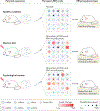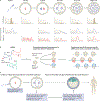Sperm RNA code programmes the metabolic health of offspring
- PMID: 31235802
- PMCID: PMC6626572
- DOI: 10.1038/s41574-019-0226-2
Sperm RNA code programmes the metabolic health of offspring
Abstract
Mammalian sperm RNA is increasingly recognized as an additional source of paternal hereditary information beyond DNA. Environmental inputs, including an unhealthy diet, mental stresses and toxin exposure, can reshape the sperm RNA signature and induce offspring phenotypes that relate to paternal environmental stressors. Our understanding of the categories of sperm RNAs (such as tRNA-derived small RNAs, microRNAs, ribosomal RNA-derived small RNAs and long non-coding RNAs) and associated RNA modifications is expanding and has begun to reveal the functional diversity and information capacity of these molecules. However, the coding mechanism endowed by sperm RNA structures and by RNA interactions with DNA and other epigenetic factors remains unknown. How sperm RNA-encoded information is decoded in early embryos to control offspring phenotypes also remains unclear. Complete deciphering of the 'sperm RNA code' with regard to metabolic control could move the field towards translational applications and precision medicine, and this may lead to prevention of intergenerational transmission of obesity and type 2 diabetes mellitus susceptibility.
Conflict of interest statement
Competing interests
The authors declare no competing interests.
Figures



References
-
- Barres R & Zierath JR The role of diet and exercise in the transgenerational epigenetic landscape of T2DM. Nat. Rev. Endocrinol 12, 441–451 (2016). - PubMed
-
- Skvortsova K, Iovino N & Bogdanovic O Functions and mechanisms of epigenetic inheritance in animals. Nat. Rev. Mol. Cell Biol 19, 774–790 (2018). - PubMed
Publication types
MeSH terms
Substances
Grants and funding
LinkOut - more resources
Full Text Sources
Other Literature Sources
Medical

